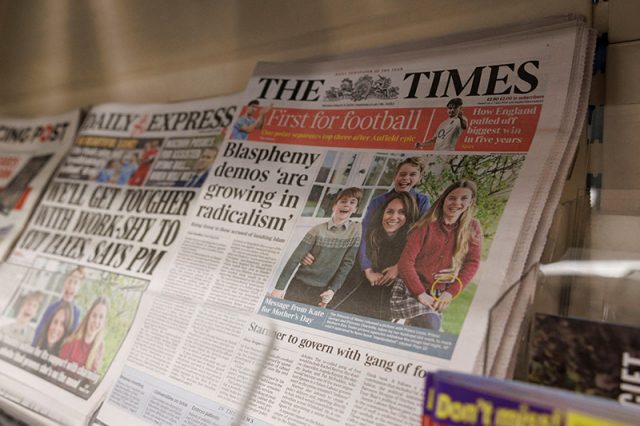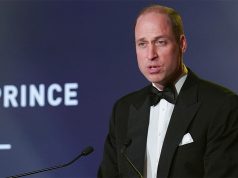
Positive public reaction was probably top of mind for Kate Middleton, the Princess of Wales, when she purportedly engaged in some homespun editing of a family picture that has landed her in the international media’s bullseye.
While some might consider the brouhaha surrounding her alleged photo editing mishap a tempest in a teapot, it teaches an important lesson on the value of employing strategic public relations counsel to build trust and transparency and avoid creating a media crisis.
There were several conditions that created a perfect storm for the photo to come under the media microscope. First, the Royal Family has been impacted by serious health issues — Kensington Palace says Kate was hospitalized in January for an unspecified abdominal surgery and is now recovering, while Buckingham Palace says, and King Charles has confirmed, that he has been diagnosed with cancer and is now undergoing treatment.
But how each announcement was made makes all the difference in why King Charles has garnered so much sympathy while the Princess of Wales’s situation has been regarded with suspicion and criticism.
Two different PR approaches
The public relations team at Buckingham Palace did an effective strategic communications job of telling the public about the nature of the King’s illness and then creating a narrative for his subsequent treatment.
Since the diagnosis, he has made several public and virtual appearances, given updates on his health and treatment, showcased his commitment to continued service and shown deep empathy for fellow cancer patients.
There are good reasons for this that are in the public interest — men do not get themselves checked for prostate cancer enough and the King’s publicity around the matter may spur them to do so, thus saving lives.
For the Princess of Wales, there are several factors at play that might make such an approach more complicated. As a woman, she faces different standards and reactions than men do when it comes to health and publicity.
In fact, it’s well-documented that women public figures face greater criticism than men, particularly around gendered notions of health and well-being.
So it’s reasonable to believe Kate wants and deserves privacy about the specific nature of her condition. Kensington Palace says she had abdominal surgery, that she would be in hospital for 14 days and that her recovery would take some time.
That level of public communications was good enough for that moment. However, since then, there’s been silence.
Silence fuels suspicion, speculation
Unfortunately staying silent sent a loud message to the media and public — something may be seriously wrong with the Princess of Wales. Even when sensational online speculation included theories about whether she was dying or had passed away, Kensington Palace made the serious error of remaining silent.
The apparent intent to protect her privacy left a media void, and social media enthusiasts and the British tabloids, in particular, abhor a vacuum. They will fill it with wild speculation in the absence of official comment.
This is particularly true in the context of British celebrity, royal-watching and tabloid media, which is a highly competitive, often brutal space. Questions about Kate really heated up when Prince William cancelled his scheduled appearance at his godfather’s funeral because of a “personal matter.”
The media’s gaze immediately returned to Kate’s condition, given the lack of transparency and strategic media outreach.
Kate’s silence about her condition and then the manipulated family picture were a missed opportunity both to protect her privacy and to build trust with the public.
Public communications is built on trust and transparency, so the lack of official comment and storytelling around her condition and recovery has caused a media furore. The media and the public expect information, especially about public figures like the future queen of the United Kingdom.
People have a certain right to privacy, but for those who will one day ascend to the British throne, there’s no absolute right to privacy, even if their leadership has become largely symbolic. So silence about Kate’s condition, surgery and recovery has created a lack of trust and transparency within the media and the public.
Global maelstrom
Releasing the manipulated family picture on Instagram and issuing it to the world’s biggest news agencies turned a story that was already being scrutinized into an international maelstrom after those organizations put out what are known as “kill notices” and withdrew the image. Kensington Palace’s refusal to provide an original, untouched photo has only fueled global speculation.
Princess Kate could have garnered significant social capital with the public by strategically sharing her story and — like the King did with the global community of cancer patients — built a bridge of empathy, education and shared experience.
This would have helped engender more trust in the princess, Kensington Palace and the Royal Family rather than diminish it. Indeed, personal and discreet storytelling regarding her condition could have created a narrative that satisfied the media’s need to know while keeping the specifics of her condition beyond the view of the always peering British and global media.
The problem here is not so much altering a photo, but the fact that the entire narrative of Kate’s condition has been silence rather than effective strategic communications and storytelling about her experience.
The moral of the story is that sound and strategic communications counsel is priceless. More effective framing and storytelling at the time of the princess’s apparent surgery and during her recovery would have helped better protect her privacy, while fostering trust and transparency with the public.![]()
Terry Flynn, Graduate Director and Associate Professor, Master of Communications Management Program, McMaster University and Alex Sévigny, Associate Professor, Department of Communication Studies and Media Arts, McMaster University. This article is republished from The Conversation under a Creative Commons license. Read the original article.









